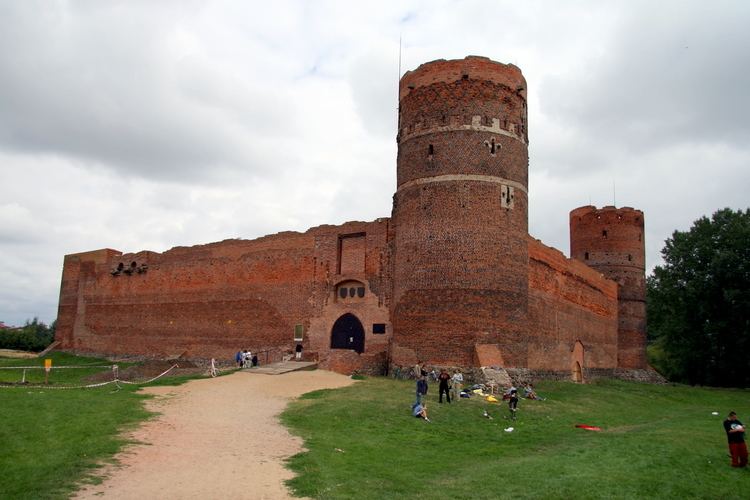Country Poland Established 11th century Highest elevation 151 m (495 ft) Population 45,902 (2006) Local time Saturday 6:45 PM | County Ciechanów County Town rights 1400 Area 32.51 km² Voivodeship Masovian Voivodeship | |
 | ||
Gmina Ciechanów (urban gmina) Weather 8°C, Wind E at 8 km/h, 71% Humidity | ||
Ciechanów [t͡ɕeˈxanuf] is a town in north-central Poland with 45,900 inhabitants (2006). It is situated in Masovian Voivodeship (since 1999). It was previously (1975–98) the capital of Ciechanów Voivodeship.
Contents
- Map of Ciechanow Poland
- History
- World War II
- Monuments
- Education
- Notable people
- Twin towns Sister cities
- References
Map of Ciechanow, Poland
History
The settlement is first mentioned in a 1065 document by Bolesław II the Bold handing the land over to the church. The medieval gord in Ciechanów numbered approximately 3,000 armed men, and together with the province of Mazovia, it probably became part of the Polish state in the late 10th century.
In 1254, Ciechanów is mentioned as the seat of a castellany (Rethiborius Castellanus de Techanow (Racibor, Kasztelan Ciechanowa)). In 1400 Janusz I of Czersk granted Ciechanów town privileges. The area eventually become a separate duchy with Casimir I of Warsaw using the title "dominus et heres lub dominus et princeps Ciechanoviensis."
In the Middle Ages, the defensive gord of Ciechanów protected northern Mazovia from raids of Lithuanians, Yotvingians, Old Prussians and later, the Teutonic Knights. It is not known when it was granted a town charter. This must have happened before 1475, as a document from that year, issued by Duke Janusz II of Warsaw, states that Ciechanów has a Chełmno town charter.
In the period between the 14th and 16th centuries, Ciechanów prospered with the population reaching 5,000. In the late 14th century, Siemowit III, Duke of Masovia, began construction of a castle, while his son Janusz I of Warsaw invited the Augustinians, who in the mid-15th century began construction of a church and an abbey. In 1526, together with all Mazovia, Ciechanów was annexed by the Kingdom of Poland. In the Masovian Voivodeship, Ciechanów was the seat of a separate administrative unit, the Land of Ciechanów.
The town was handed over to Bona Sforza, as her dowry. Ciechanów prospered until the Swedish invasion of Poland (1655-1660), when the town was burned and ransacked.
After the second partition of Poland (1793), Ciechanów briefly became seat of a newly created voivodeship. In 1795, it was annexed by the Kingdom of Prussia, and reduced to the status of a provincial town in Przasnysz county. In 1806, during the Napoleonic Wars, Ciechanów was ransacked and destroyed. Since 1815, the town belonged to Russian-controlled Congress Poland. Its residents actively supported Polish rebellions. In the late 19th century, Ciechanów emerged as a local trade and industry center. In 1864, a brewery was opened, in 1867 it became seat of a county, in 1877 a rail station of the Vistula River Railroad was completed, and in 1882 a sugar refinery was opened. The period of prosperity was short, as during World War I, Ciechanów was almost completely destroyed.
In the Second Polish Republic, Ciechanów remained seat of a county in Warsaw Voivodeship. In 1938, its population was 15,000, and the town was a military garrison, home to the 11th Uhlan Regiment of Marshall Edward Smigly-Rydz.
World War II
Ciechanów was captured by the Wehrmacht on the night of September 3/4, 1939. The town was annexed by Nazi Germany and was known as Zichenau in German. It was the capital of Regierungsbezirk Zichenau, a new subdivision of the Province of East Prussia. On January 17, 1945, Ciechanów was captured by the Red Army, and was restored to Poland after the war.
Before World War II, it was home to a large Jewish community but during the Nazi occupation, in the winter of 1942, the majority of the Jewish community were transported to the Red Forest (Czerwony Bór) north-east of town and murdered by gunfire. During the war many Polish Jews and resistance fighters were executed by the Germans in the castle.
Monuments
Education
Notable people
Twin towns – Sister cities
Ciechanów is twinned with:
